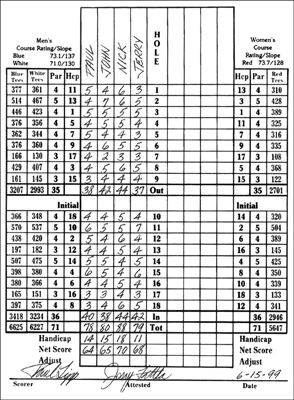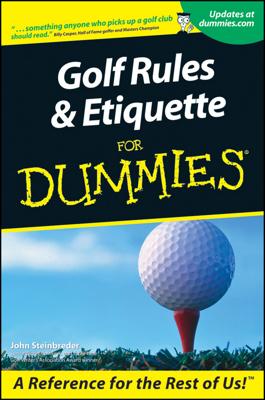Scoring in golf allows you to easily see how you’re doing. Every course you play has a score card that tells you each hole’s length, its par, and its rating relative to the other holes. You fill in your group's scores after each hole.

The score card tells you which holes to subtract handicap strokes from. The holes are rated 1 through 18 in terms of handicap (abbreviated Hcp on the score card). These numbers rank the holes, in the opinion of the club committee, from hardest to easiest. The hole rated 1 is the toughest, and the hole rated 18 is the easiest.
Although you have to report your score every time you set foot on the golf course (stroke play), most of your golf will typically be matches against others (match play), which is why each hole’s rating is important:
Match play: In match play, you don’t have to write down any score. The only thing that matters is the state of the game between you and your opponent. The score is recorded as holes up or holes down. For example, say your score on the first hole was 4, your friend's score was 5, and you received no strokes on that hole. Your friend is now one up.
Because each hole is a separate entity, you don’t need to write down your actual score; you simply count the number of holes you’ve won or lost. In fact, if you’re having a particularly bad time on a given hole, you can even pick up your ball and concede the hole. All you lose is that hole. Everything starts fresh on the next tee.
Such a head-to-head match ends when one player is more holes up than the number of holes remaining. Thus, matches can be won by scores of “four and three.” All that means is that one player was four holes ahead with only three left, the match finishing on the 15th green.
Stroke play: Strictly card-and-pencil stuff. With stroke play, you’re playing against everyone else in the field — or against that elusive standard, par — not just your playing companion. You count one stroke each time you swing at the ball.
You don’t record your own score. The card in your pocket has your playing companion’s name on it. You keep his score, and he keeps yours. (You may keep your own score, as well, but your playing partner keeps your official score.)
At the end of the round, he signs his name to your card and gives it to you; you do the same with his card. After you’ve checked your score for each hole, you also sign your card.
Don’t worry about the addition on your card. You aren’t responsible for that part. As long as the numbers opposite each hole are correct, you’re in the clear.

